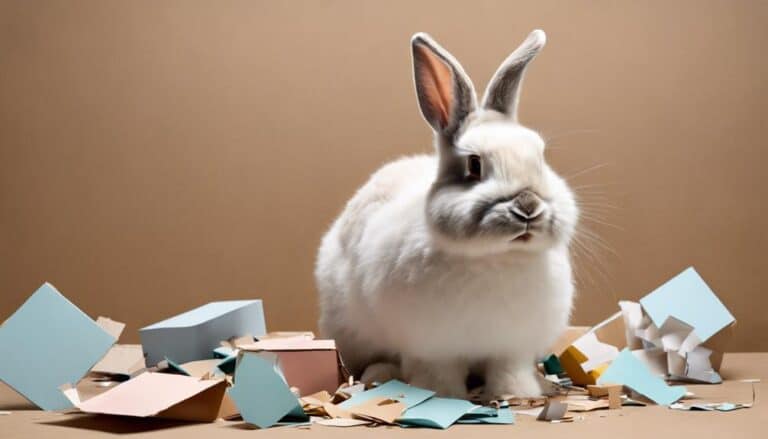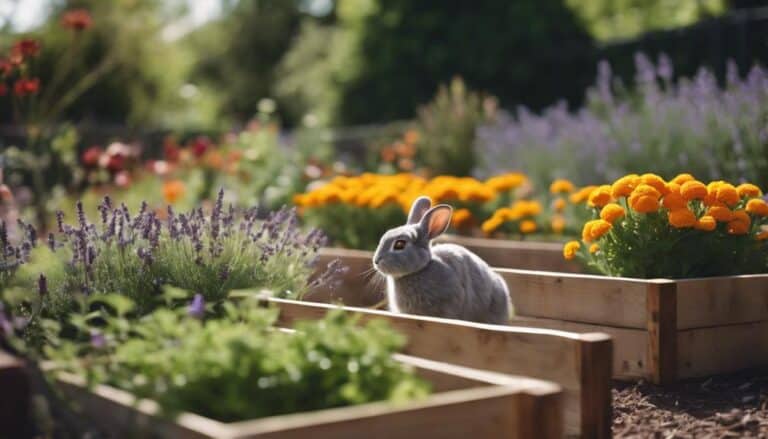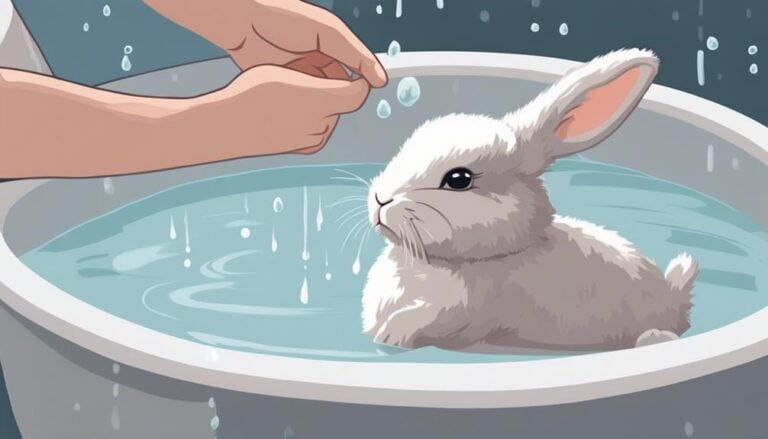So, you've pondered the age-old question: can bunnies and cats coexist in harmony?
While it may seem like an odd pairing, there are ways to navigate their potential relationship. Understanding the dynamics between these two species is key to setting the stage for a successful bond.
Curious to know how these fluffy companions can find common ground? Stay tuned to uncover the secrets of fostering a peaceful cohabitation between bunnies and cats.
Contents
- 1 Key Takeaways
- 2 Understanding Natural Instincts and Behaviors
- 3 Importance of Gradual Introductions
- 4 Factors Influencing Compatibility
- 5 Steps to Successful Cohabitation
- 6 Monitoring and Managing Interactions
- 7 Building a Harmonious Environment
- 8 Will my cat and bunny be able to share the same living space if they have different toilet habits?
- 9 Frequently Asked Questions
- 10 Conclusion
Key Takeaways
- Gradual introductions and supervised interactions are crucial for fostering a harmonious relationship.
- Creating neutral territories and positive associations help minimize conflicts from natural instincts.
- Monitoring for stress or aggression signs and providing separate spaces ensure a safe cohabitation.
- Environment, socialization, and careful supervision significantly impact the compatibility between bunnies and cats.
Understanding Natural Instincts and Behaviors
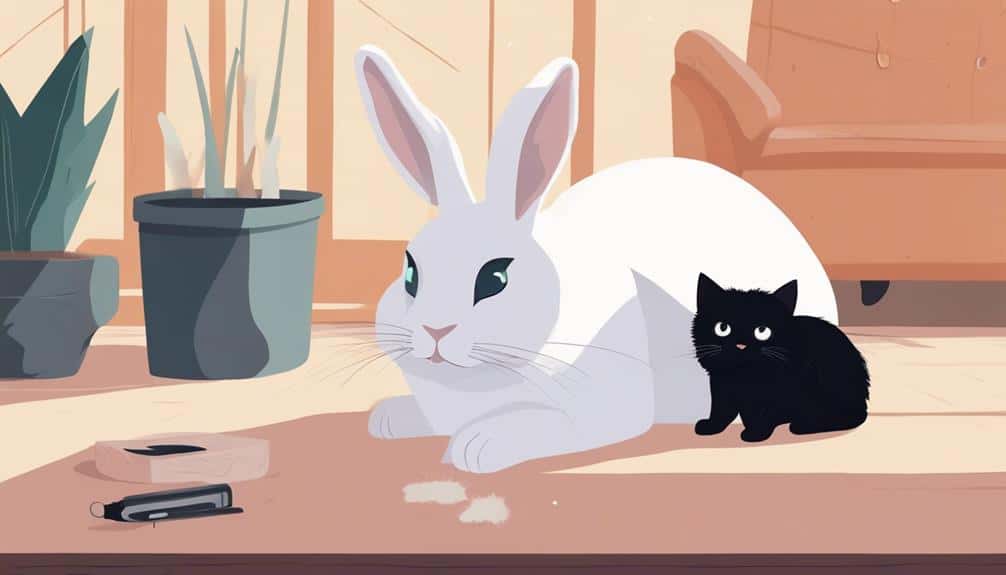
Understanding the natural instincts and behaviors of both cats and rabbits is essential for fostering a harmonious relationship between these two species. Cats, as natural predators, have a strong prey drive that can be triggered by the sight or movement of smaller animals like rabbits. On the other hand, rabbits are prey animals that exhibit territorial and dominance behaviors to protect themselves in the wild. These contrasting instincts can pose challenges when trying to integrate them into a shared living space.
Cats may view rabbits as prey, and their hunting instincts could lead to aggressive behaviors towards the rabbits. Similarly, rabbits may perceive cats as predators, triggering fear responses or territorial behaviors. To help them coexist peacefully, it's important to create a neutral territory for introductions. This neutral ground can help minimize potential conflicts arising from their natural instincts, providing a safer environment for both cats and rabbits to gradually acclimate to each other's presence.
Importance of Gradual Introductions
To facilitate a smooth and positive interaction between your cat and bunny, initiating gradual introductions is key to their successful integration and relationship-building process. By introducing them slowly, you allow both animals to acclimate to each other's scents, sounds, and presence over time. This gradual approach helps build positive associations and reduces stress during their initial interactions.
Supervised introductions provide essential opportunities for the bunny and cat to establish boundaries and communication cues, which are important for a successful relationship. Rushing this process can lead to fear, aggression, or stress-related behaviors in both pets. Hence, exercising patience and consistency in the introduction process greatly increases the likelihood of a harmonious coexistence between your bunny and cat.
Factors Influencing Compatibility

When considering the compatibility between bunnies and cats, several factors come into play. Factors such as the environment and space available, their socialization and behavior, as well as the supervision during their interactions are critical in determining their relationship.
Environment and Space
Creating a safe and enriched environment is essential in fostering positive interactions between cats and rabbits. To guarantee harmony between your pets, consider the following:
- Provide hiding places: Offering secure enclosures for rabbits during initial interactions allows them to feel safe and gradually adjust to the cat's presence.
- Trim cat's claws: Keeping your cat's claws trimmed is important to prevent accidental harm to the rabbits during their interactions, promoting a safer environment for both pets.
- Supervised access: Allowing supervised access between cats and rabbits helps them acclimate to each other at a comfortable pace, fostering familiarity and reducing potential conflicts.
Socialization and Behavior
Considering the dynamics of introducing cats and rabbits, understanding their socialization and behavior is key to fostering a harmonious relationship between these two distinct companions. The age at which they're introduced, along with their individual temperaments, greatly impacts their compatibility. Matching animals of similar size and breed can also enhance their chances of getting along.
Young cats and rabbits have a higher likelihood of forming a positive bond. Vaccinating and spaying/neutering both pets can help reduce aggression and territorial behavior, improving their overall compatibility. Being aware of their natural instincts, like cats' prey drive, can guide interactions and prevent misunderstandings.
Supervision and Interaction
To guarantee a harmonious relationship between your cat and rabbit, careful supervision and positive interactions are essential. When introducing a cat to a rabbit, follow these guidelines:
- Create Separate Spaces: Initially, keep the cat and rabbit in separate areas to prevent stress and make sure they have their own safe zones.
- Supervised Meetings: When it's time for them to meet, make sure close supervision to intervene if necessary. Start with short, controlled interactions and gradually increase their time together.
- Provide Rabbit Runs: Give your pet rabbits ample space to retreat if needed. Rabbit runs or enclosures with hiding spots can help them feel secure during interactions with the cat.
Steps to Successful Cohabitation
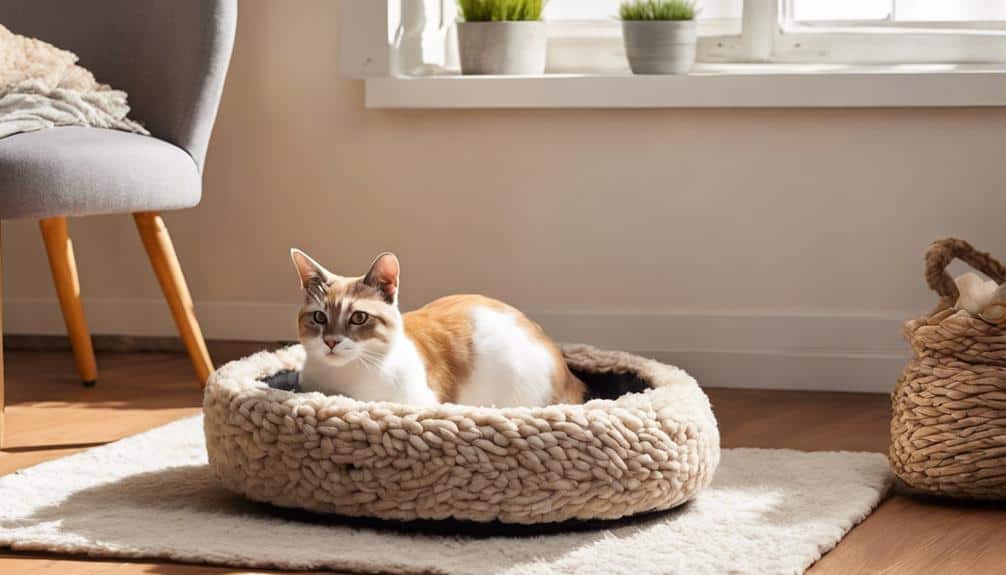
When preparing for the cohabitation of your bunny and cat, the initial steps play an important role in setting a strong foundation for their relationship. Rabbits, as prey animals, may feel anxious around domestic cats, so it's essential to introduce them gradually in a neutral space to reduce stress and promote acceptance. Monitor their interactions closely, looking out for any signs of aggression or stress, and be ready to intervene if necessary. To make sure safety, provide the rabbit with hiding spots and keep the cat's claws trimmed to prevent accidental harm.
Start with supervised interactions, beginning with short sessions and gradually increasing the duration as they become more comfortable with each other. Remember, patience is key as these animals establish their relationship. It may take time for them to coexist peacefully, so be understanding and give them the space they need to adjust. By following these steps and allowing them to acclimate at their own pace, you can help foster a harmonious bond between your bunny and cat.
Monitoring and Managing Interactions
To properly facilitate harmonious interactions between your bunny and cat, close supervision and intervention when needed are pivotal elements in ensuring a safe and peaceful cohabitation. Here are essential tips for monitoring and managing interactions:
- Stay Vigilant: Keep a watchful eye on your cat and bunny when they're together. Look for signs of stress or aggression, and be ready to step in if necessary.
- Provide Separate Playtime: Engage in play sessions with your cat separately to fulfill its hunting instincts, keeping the rabbit out of these interactions to prevent any potential issues.
- Prepare for Separation: Be prepared for the possibility of needing to keep your cat and rabbit separated if their interactions become too tense or if they aren't getting along. It's better to guarantee their safety by maintaining some distance if needed.
Building a Harmonious Environment
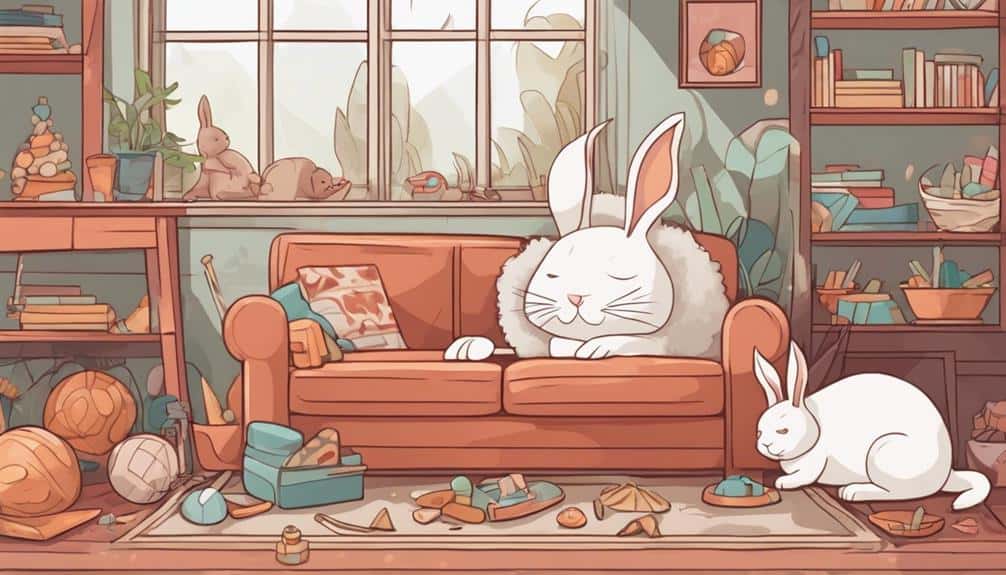
To create a harmonious environment for your bunnies and cats, it's essential to provide designated spaces for both pets where they can feel secure.
Slow and supervised introductions between your pets allow them to adjust to each other's presence gradually, reducing the chances of conflict.
Space for Both
For a harmonious coexistence between bunnies and cats, creating separate but equal spaces is essential. To foster a peaceful environment, consider the following:
- Designated Areas: Provide each pet with their own space containing hiding places to retreat to when needed.
- Vertical Spaces: Incorporate shelves or cat trees so your feline friend can observe the house rabbit without direct interaction.
- Rotating Access: Introduce barriers or utilize baby gates to establish boundaries and allow visual contact while reducing the likelihood of territorial conflicts.
Slow, Supervised Introductions
Implementing slow, supervised introductions between bunnies and cats is pivotal in establishing a harmonious environment conducive to positive interactions. Prey animals, such as bunnies, can feel vulnerable in the presence of cats, triggering stress and fear.
To ease this change, utilizing scent familiarization techniques can help both animals become accustomed to each other's presence before direct contact. By gradually allowing them to interact under close supervision, you can observe their behavior and intervene if necessary to ensure safety.
This approach not only promotes peaceful coexistence but also helps in building trust and reducing the chances of conflicts. Remember, patience, and careful monitoring are key in fostering a harmonious relationship between bunnies and cats.
Yes, your cat and bunny can share the same living space even if they have different toilet habits. However, it’s crucial to provide separate litter boxes for each pet to avoid any conflicts. As for the bunnies, it’s perfectly fine to have two bunnies using the same litter box.
Frequently Asked Questions
Can a Cat and a Bunny Live Together?
Yes, a cat and a bunny can live together successfully. By using bonding techniques, introducing them slowly, establishing territory, supervising interactions, providing positive reinforcement, and offering separate spaces, you can foster a harmonious relationship between them.
What Animals Can Live With Rabbits?
Dogs can be great companions for rabbits, while guinea pigs make friendly friends. Birds can also be good roommates. Turtles can be buddies, but hamsters might not play well. Fish can be peaceful neighbors in separate tanks.
Why Is My Rabbit Chasing My Cat?
When your rabbit chases your cat, it may be due to animal behavior linked to prey instincts or establishing dominance. Implement socialization techniques, provide enriching environments, and learn to read communication signals to foster a harmonious relationship between your pets.
Can a Rabbit Survive a Cat Bite?
Yes, a rabbit may not survive a cat bite due to their vulnerable skin and bone structure. Immediate veterinary care is essential to prevent severe injuries and infections. Keeping cats and rabbits separated is necessary for their safety.
Conclusion
To sum up, bunnies and cats can get along with proper introductions and supervision. By understanding their natural instincts, taking gradual steps, and creating a harmonious environment, pet owners can foster a positive relationship between these two species.
Remember to prioritize safety and patience to make sure a peaceful cohabitation between bunnies and cats. With the right approach, these animals can form a bond that brings joy and companionship to your home.



